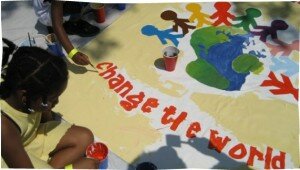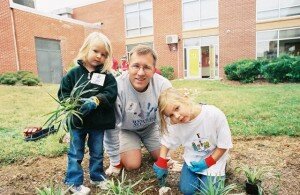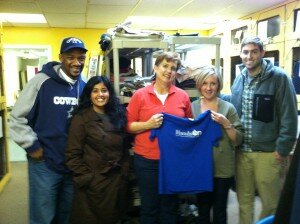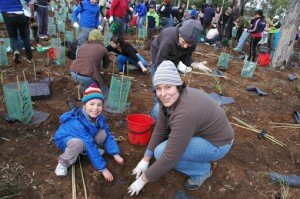Today’s guest post was written by Laura Rog, the Director of Training and Technical Assistance with generationOn. 
The holiday season is a great time for reflection about the world, the service that we do, and our role as agents of change in the community. It is a time when many of us are reminded of what we are thankful for and can use the spirit of giving to inspire us in the new year ahead.
As we move forward with an infusion of goodwill over the next couple months, it’s important to stop and think about how we encourage youth to understand and interpret their service experiences in the holiday season (and all year long!).
Service, while often an amazing and transformative experience, can also be a place where stereotypes and assumptions are reinforced if volunteer opportunities are not handled with compassion and empathy. As adults passing on a culture of service to our students, youth, and children, it is crucial that we think about how we communicate societal values through service experiences.
A central focus in any quality volunteer experience for youth should be the idea that they are serving WITH others, not FOR other s. This idea incorporates the concept of Neighboring, or the idea that communities – especially those in underserved and under resourced areas – should be engaged in their own change, not have solutions scripted for them by outsiders. As we engage our children and students this holiday season, it’s important to think deeply about this model. When you are out purchasing food, clothing, toys, or other goods to donate to holiday collections, or participating in service with organizations to create change, what can you do to extend the connection with the populations on the receiving end?
s. This idea incorporates the concept of Neighboring, or the idea that communities – especially those in underserved and under resourced areas – should be engaged in their own change, not have solutions scripted for them by outsiders. As we engage our children and students this holiday season, it’s important to think deeply about this model. When you are out purchasing food, clothing, toys, or other goods to donate to holiday collections, or participating in service with organizations to create change, what can you do to extend the connection with the populations on the receiving end?
There are a number of things you can do to create substance in our holiday service experiences, but three key places to start include:
1. Our Words – Pay attention to the words you use to describe those with whom you are serving. Negative descriptors should be avoided at all costs – for example, talking about the “needy kids” or “poor families” you’ll be helping. Using words like these to describe others labels them and creates an image of permanent condition. It’s a way we as a society create an image that poverty and other conditions are self-created rather than the result of a complex set of factors. Resist the urge to give a simplistic explanation to the youth you are working with and have longer/multiple conversations to cover the societal conditions surrounding your service projects.
2. Our Actions – Remember that action counts, but the results aren’t the only factor to consider. Too often, and especially around the holidays, collections are turned into a competition. We’ve all seen this – the class with the most cans wins a pizza party, the club with the most change in their bucket gets a field trip. How does being rewarded foster empathy? In short, it doesn’t. Instead of creating a competition, find ways to celebrate ALL students’ efforts – for example, hold a school-wide assembly to publicly donate their collection to the service organization it’s benefiting, or find ways for the students to visit the organization and volunteer wrapping the items or stacking the shelves with their food items.
3. Our Time – Every moment is an opportunity for learning, but true learning doesn’t happen in a moment. As adults we need to remind ourselves that for learning with depth, youth need quality amounts of time to spend around an issue. It’s easy to do a quick lesson or family project at the holidays, but when you make it meaningful youth become active citizens rather than passive helpers. Volunteering as a family on a regular basis, or extending short service projects into service-learning experiences, allow youth time to process and get into depth with an issue in the community. Additionally, taking quality time for reflection as a family or classroom helps youth to understand their reactions and process the larger societal issues they are seeing.
The holidays are a perfect time to renew your service spirit and reaffirm your civic engagement. Have a fantastic holiday season and enjoy the opportunities it brings to share a commitment to service with the youth in your life!
For further information on Neighboring, download the HandsOn Network’s Neighboring Toolkit.


 will be a piece of cake because this is our bread and butter.” (Yes, a delicious mix of metaphors, appropriate for the holiday!)
will be a piece of cake because this is our bread and butter.” (Yes, a delicious mix of metaphors, appropriate for the holiday!) Home. A week at
Home. A week at  What I did not know, is that it may be something that Seattle and one or two other cities co-create and try out at the same time. It may involve a combo of new things built from scratch here, and importing things that are working elsewhere but not yet happening in Seattle.
What I did not know, is that it may be something that Seattle and one or two other cities co-create and try out at the same time. It may involve a combo of new things built from scratch here, and importing things that are working elsewhere but not yet happening in Seattle. Winter is coming.
Winter is coming. Heavy snow fall and ice storms can paralyze cities, making travel difficult and sometimes making even going outside dangerous.
Heavy snow fall and ice storms can paralyze cities, making travel difficult and sometimes making even going outside dangerous. Do you know what to do if your city essentially shuts down for three days (or more) because of winter weather? What if you lose power because of ice bringing down power lines?
Do you know what to do if your city essentially shuts down for three days (or more) because of winter weather? What if you lose power because of ice bringing down power lines? Make sure you have a disaster kit with at least a three day supply of food and water (one gallon per person per day), battery or hand-crank powered radio and flashlight, medicine, baby supplies (if needed), extra pieces of warm clothing and blankets, and extra supplies for your pets.
Make sure you have a disaster kit with at least a three day supply of food and water (one gallon per person per day), battery or hand-crank powered radio and flashlight, medicine, baby supplies (if needed), extra pieces of warm clothing and blankets, and extra supplies for your pets.
 Protect yourself from frostbite and hypothermia by dressing in multiple layers of loose fitting clothing (tight clothing can restrict blood flow)
Protect yourself from frostbite and hypothermia by dressing in multiple layers of loose fitting clothing (tight clothing can restrict blood flow)
 Today’s post comes from Alice Speck, a stay at home mom and education advocate in Washington, DC.
Today’s post comes from Alice Speck, a stay at home mom and education advocate in Washington, DC. We head off to school in the morning, and pass
We head off to school in the morning, and pass  We drive home from Whole Foods and again pass Shaw at Garnet-Patterson Middle School. They’re collecting shoes for the community.
We drive home from Whole Foods and again pass Shaw at Garnet-Patterson Middle School. They’re collecting shoes for the community.

 volunteer to do something you wouldn’t normally do.
volunteer to do something you wouldn’t normally do.






 s. This idea incorporates the concept of Neighboring, or the idea that communities – especially those in underserved and under resourced areas – should be engaged in their own change, not have solutions scripted for them by outsiders. As we engage our children and students this holiday season, it’s important to think deeply about this model. When you are out purchasing food, clothing, toys, or other goods to donate to holiday collections, or participating in service with organizations to create change, what can you do to extend the connection with the populations on the receiving end?
s. This idea incorporates the concept of Neighboring, or the idea that communities – especially those in underserved and under resourced areas – should be engaged in their own change, not have solutions scripted for them by outsiders. As we engage our children and students this holiday season, it’s important to think deeply about this model. When you are out purchasing food, clothing, toys, or other goods to donate to holiday collections, or participating in service with organizations to create change, what can you do to extend the connection with the populations on the receiving end?

 carpentry, become more social, or practice a new language? You can do all these things through volunteering! Volunteering is the perfect way to discover something that you’re really good at while contributing to the benefit of your community (it’s a win-win situation).
carpentry, become more social, or practice a new language? You can do all these things through volunteering! Volunteering is the perfect way to discover something that you’re really good at while contributing to the benefit of your community (it’s a win-win situation).


